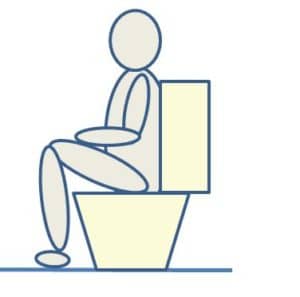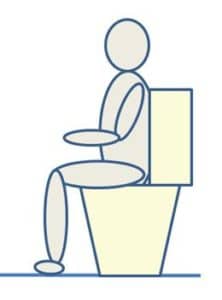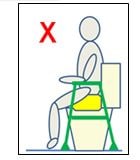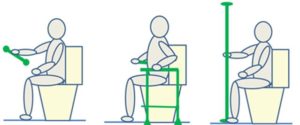Taking Care When Managing Continence
Click here to print the Taking Care when Managing Continence guide
Getting to the toilet on time may be difficult if the person has problems with strength, stamina, or mobility or with memory, orientation, and understanding.
It is important to empty the bladder and bowel regularly for general health, to stay continent, and to avoid constipation and urine infections.
Here are some tips to help support a person to use the toilet safely and effectively.
A healthy diet and plenty to drink are important to keep bladder and bowel functioning well. If the person’s diet or medical condition is affecting bladder or bowel function, contact their GP or the Bladder and Bowel Service for advice.
The best position for going to the toilet is sitting down on the toilet with feet on the floor and knees level with the hips or higher than the hips. This position will help the bladder and bowel to empty properly. If the toilet seat is too high it stops the bladder and bowel from emptying fully and this can lead to urine infections or constipation.

Getting on and off the toilet safely can be difficult and it may be tempting to add a high seat to the toilet to make this easier, but high seats prevent the bladder and bowel emptying effectively. Instead of a high seat, use rails that fit around the toilet or rails fixed to the wall, to give a firm hold when getting up from the toilet.
Commodes can be useful, especially if the person’s bed or chair is a long way from the toilet. Most commodes can be adjusted, so the height is right for effective use. Some are wheeled and can be positioned over the toilet. Commodes with a large bucket or chemical commodes are also available for times when the bucket can’t be emptied straight away.
Urinal bottles and other urinal containers are available for men and women and can be useful when it is difficult to get to the toilet. To make them easier to use and to prevent spills when emptying, some have lids or a collection bag attached and some are shaped for use when lying down. Disposable urinal bags are also available.
Clothes that are loose-fitting with simple fastenings or elasticated waist, can help to get to the toilet in time. Longer zip fly fastenings are easier for men who stand at the toilet. Velcro tends to catch on other clothes and can come undone under pressure.
Pads might get in the way when going to the toilet; washable pants with a built-in pad, stick-on pads or pull-up pads may be easier. Nighttime pads are extra absorbent for greater protection and there are waterproof protection pads for use on beds and chairs; be aware of the risk of skin damage when sitting or lying on extra layers or damp surfaces.
Cleaning after using the toilet is easier if the toilet seat has a big opening. If it is difficult to hold the toilet tissue or to reach to clean effectively, there are bottom wiping gadgets, douche sprays, and toilet bidets to help to wash and dry after using the toilet.
Taking Care to Manage Continence when disorientated or forgetful.
Getting to the toilet on time can be affected by memory loss or disorientation; the person may not recognise the feeling that they need to go to the toilet, they may not remember to go regularly, may not be able to find or recognise the toilet and may forget to use it properly when they are there.
Tips to overcome memory or orientation problems when going to the toilet:
Remind the person to go
- Establish a routine with reminders to go to the toilet regularly. Written reminders may be enough, or audible and picture reminders can be set up on a mobile phone or interactive reminder screen.
- Reminder screens and cups designed with audible reminders can be used to help the person to remember to drink enough fluid to encourage bladder and bowel function.
Make sure they can find the toilet:
- Keep the route to the toilet clear and well-lit, especially at night. Movement sensor plug-in night lights can be useful to guide the person to the toilet and back to bed.
- Make sure the toilet door is visible, recognisable, and easy to open and close.
- The toilet should be clearly recognisable as a toilet. Unusual coloured seats can be distracting especially if the colour is not one that is usually associated with the toilet.
- Keep the toilet area uncluttered so that there are few distractions.
Help to get them there on time:
- Familiar clothing, with an elasticated waist or simple fastenings, is easier to get on and off successfully. Velcro tends to catch on other clothes and come undone under pressure.
- If pads are needed; washable pants with built-in pads or all-in-one pull-up disposable pads or adhesive pads that stick to pants are easier when getting going to the toilet.
Make sure they use the toilet effectively:
- Give the person privacy and time to use the toilet and fully empty their bladder and bowel in a calm environment.
- When sitting on the toilet the person may need reminding to use it.
- If guidance is needed, use clear instructions with familiar phrases.
- Encourage the person to lean forwards, if safe to do so, when sitting on the toilet, to create gentle downward pressure that helps the bladder and bowel to empty.
If the person has a medical condition that is affecting continence; Contact their GP or a nurse from the Bladder and Bowel Service for advice.


